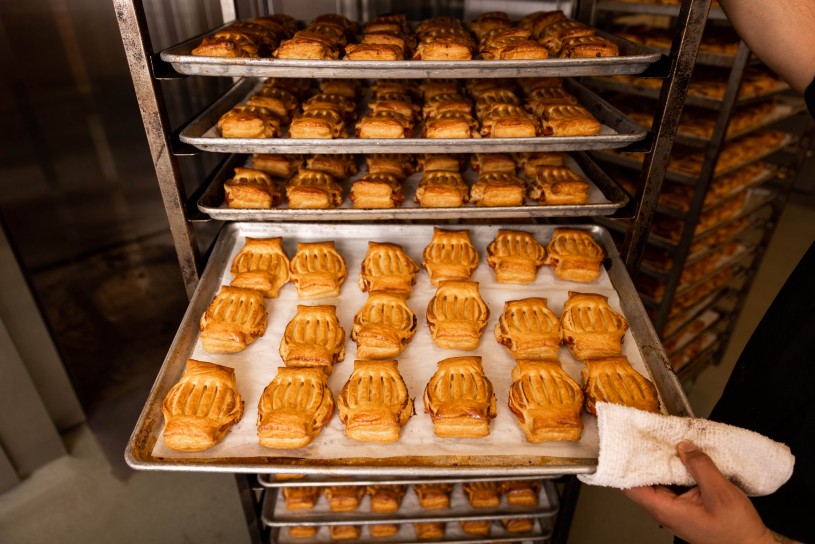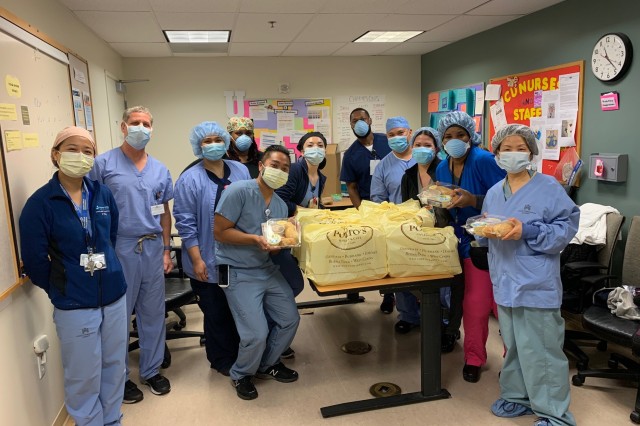
story
Beatriz Porto | Porto’s Bakery

Porto’s Bakery is an L.A. icon. But who is the family behind the bakery and the creators of the legendary guava cheese pastry—the refugiado? In an interview co-owner of Porto’s Bakery, Beatriz Porto tells us about the start of her family's bakery at their home in Cuba, the important meaning behind the refugiado, and how Porto’s has helped support communities in L.A.

Really the community was the one that supported our household buying our cakes, for friends, families, the whole neighborhood.
Beatriz Porto
My name is Beatriz Porto, and I am one of the owners, along with my siblings, of Porto's Cafe. We started Porto’s out of necessity. My mom, Rosa Porto, and dad, Raul Porto, started the small bakery on Sunset and Silver Lake. We kids did what we had to do to support the business, whether it was dishes or learning how to bake. My sister and I became cake decorators just by watching my mother! So becoming this big name wasn't deliberate. I just started helping out my family because that's what you had to do. All of us would come out of school and help every day.

Porto's Bakery
(From left to right) Margarita Porto, Raul Porto Jr., and Betty Porto are the second generation of Portos to run the family business. This photo was taken in 1966 in Cuba and they are posing with cakes made by their mother, Rosa Porto.

Porto's Bakery
Rosa Porto, Raul Porto, and their daughter Margarita Porto standing in front of one of Rosa's cakes.

Porto's Bakery
Founder of Porto's Bakery, Rosa Porto, as a young girl living in Cuba.
1 of 1
(From left to right) Margarita Porto, Raul Porto Jr., and Betty Porto are the second generation of Portos to run the family business. This photo was taken in 1966 in Cuba and they are posing with cakes made by their mother, Rosa Porto.
Porto's Bakery
Rosa Porto, Raul Porto, and their daughter Margarita Porto standing in front of one of Rosa's cakes.
Porto's Bakery
Founder of Porto's Bakery, Rosa Porto, as a young girl living in Cuba.
Porto's Bakery
We lived in Cuba when we started. In 1962, our family presented papers to leave the country. It was a difficult time because both my parents were fired from their jobs. Prior they had made very good salaries, and then we went from that to making zero dollars. Our neighbor told my mother, “Hey, you got to start making those cakes that you make for your kids, for everybody else, because you need to make some money”. My mother was a talented baker—she was self-taught and so that is how we got started. But money was illegal, and you were not supposed to have a private enterprise. Every day, my mother ran the risk of being caught and going to jail for 25 years. We were lucky enough to live in a neighborhood where our neighbors would tell us when the secret police were coming. Through the backyard, my mother would quickly get everything (baking supplies) out of the house. She was doing that until we left for the United States in 1971.

Really the community was the one that supported our household buying our cakes, for friends, families, the whole neighborhood. So finally in 1971, we were able to come to Los Angeles and again, I found out that friends and family were here! There was a large Cuban community from our town so when they found out she was in Los Angeles the orders started. She was here only a month when she made her first wedding cake.
So she went from Cuba baking illegally to the U.S. baking out of her home again. My brother says she never went to bed because she would have to make three wedding cakes every weekend. That means she was baking all night long. And sometimes we would go to the movies and come back and she was still baking. She would put baking sheets on our beds, to cool the cakes because she didn't have enough room. Then she realized that there's not enough space she needed to rent the place to bake. That's exactly what she did. In 1976, she opened her first little 300 square foot bakery on Sunset and Silver Lake.

Porto's Bakery
(From left to right) Raul Sr., Margarita, Rosa, Betty, and Dolores Porto (Raul Sr.’s mother), photographed in 1976 outside the original Porto's Bakery located in Silver Lake, California.

Porto's Bakery
Beatriz Porto (in front of the counter) and Margarita Porto, photographed inside the original Porto's Bakery in 1976.
1 of 1
(From left to right) Raul Sr., Margarita, Rosa, Betty, and Dolores Porto (Raul Sr.’s mother), photographed in 1976 outside the original Porto's Bakery located in Silver Lake, California.
Porto's Bakery
Beatriz Porto (in front of the counter) and Margarita Porto, photographed inside the original Porto's Bakery in 1976.
Porto's Bakery
In the beginning, at the Sunset and Silver Lake location, we were surrounded by friends and family. So it was a great place to be. Mind you, over the years, we changed menus to serve the Mexican community. We had a Mexican baker who started to teach my brother how to make conchas and we still sold all the Cuban cakes and goodies my mother made, but we also were serving the community. We understood that there was a community we were at. Whatever was needed was what we were making.
But then in the 1980s something came up. There was a baker who went out of business and was selling his 3,000 sq foot bakery. At the time there were like 100,000 Cubans living in Glendale and we went after our community. We bought the bakery. We didn't have an issue because our customers showed up. We started making donuts too because that's what the people in the area wanted to eat, donuts, bear claws, and stuff like that. So again, we had to reinvent ourselves but we always stuck to our core products, like croquettes, potato balls, and the guava and the guava cheese pastries. The thing is that people were coming to us, no matter where we went. Which is true to this day. The same products that my mother was selling out of the house are the ones we are still selling 40 something years later. It's amazing.

There's nothing more to Cuban than guava and cheese. It was inexpensive. So my mother thought why don’t you put it inside a pastry? It was never done before, no one was selling it at the time. So we decided to make it and the reason we call it refugiado or refugee, remember we just got here, and when we came from Cuba that's what we were called. For us, it's a comfort food. It is what being Cuban-American is all about.

It just gives a sense of our survival because really we're here as immigrants or refugees to survive. We're here and we're here to stay. We wanted to mark our arrival, our presence in this country so we brought something that we love to everybody here in Los Angeles. Without realizing it, the refugiado has become a staple in Los Angeles. Now the people that are buying the refugiado are not just Cubans, there are Filipinos, Chinese, Salvadoreans who love our pastries. We also have the whole United Nations visiting us! People that come from other countries and they say when they get off the plane the first place they want to go is Porto's. When we created the recipe we really did it for ourselves—without knowing that people would fall in love with it.

The name sparks memories and emotions. We call it refugiado to remind ourselves how we got here, and why we came to the United States. We are refugiados, refugees, so we never wanted to forget that. So that's why we gave it the name. To the ones that understand the struggle it is there as a reminder always.

Oh yeah, when it comes out of the oven and we get to sample it! You can see the flaky dough getting brown and you see the guava and the cream cheese oozing through the sides. I am always on the lookout for that. I mean they look incredible, anything that comes out of the oven.

Well, we started in one community, but now we're a part of multiple communities. We make an effort to choose either a service organization, or the local police or fire department to donate our pastries to that weren't purchased. For example, if you volunteer with a Union Rescue Mission, you're gonna see Porto’s pastries when you go there. When I visit the Mission, I'm like a rock star because they know where the cookies are coming from. It's really a nice way to build community. My mother never wanted to throw any food away because she knew how many people needed to be fed. So it’s something that we’ve been doing forever and ever.

Porto's Bakery
During the pandemic Porto's Bakery has made countless donations to first responders at local hospitals.

Porto's Bakery
Porto's bakery also makes donations to nonprofits and homeless shelters like the Union Rescue Mission.

Porto's Bakery
Porto's Bakery also honors our Service Veterans providing them with delicious meals.
1 of 1
During the pandemic Porto's Bakery has made countless donations to first responders at local hospitals.
Porto's Bakery
Porto's bakery also makes donations to nonprofits and homeless shelters like the Union Rescue Mission.
Porto's Bakery
Porto's Bakery also honors our Service Veterans providing them with delicious meals.
Porto's Bakery
To see what's baking at Porto’s Bakery check out portosbakery.com and find your nearest location to taste the delicious flaky layers of the refugiado.
Do you know an L.A. breadmaker who lovingly connects to your community? Do you want to share your favorite experience at Porto's Bakery? Join the conversation by tagging @NHMLA with #KneadedLA, and your story could be featured next!
Following the success of Kneaded: L.A. Bread Stories, we're celebrating the history, heritage, and communities of Los Angeles through the lens of different cultural traditions. This year, L.A. at Play highlights the vibrant and visionary work of artisans who fabricate dolls and figurines using a variety of techniques and materials.